lock RENAULT TWINGO RS 2009 2.G Electrical Equipment - Petrol Injection Owner's Manual
[x] Cancel search | Manufacturer: RENAULT, Model Year: 2009, Model line: TWINGO RS, Model: RENAULT TWINGO RS 2009 2.GPages: 348
Page 121 of 348
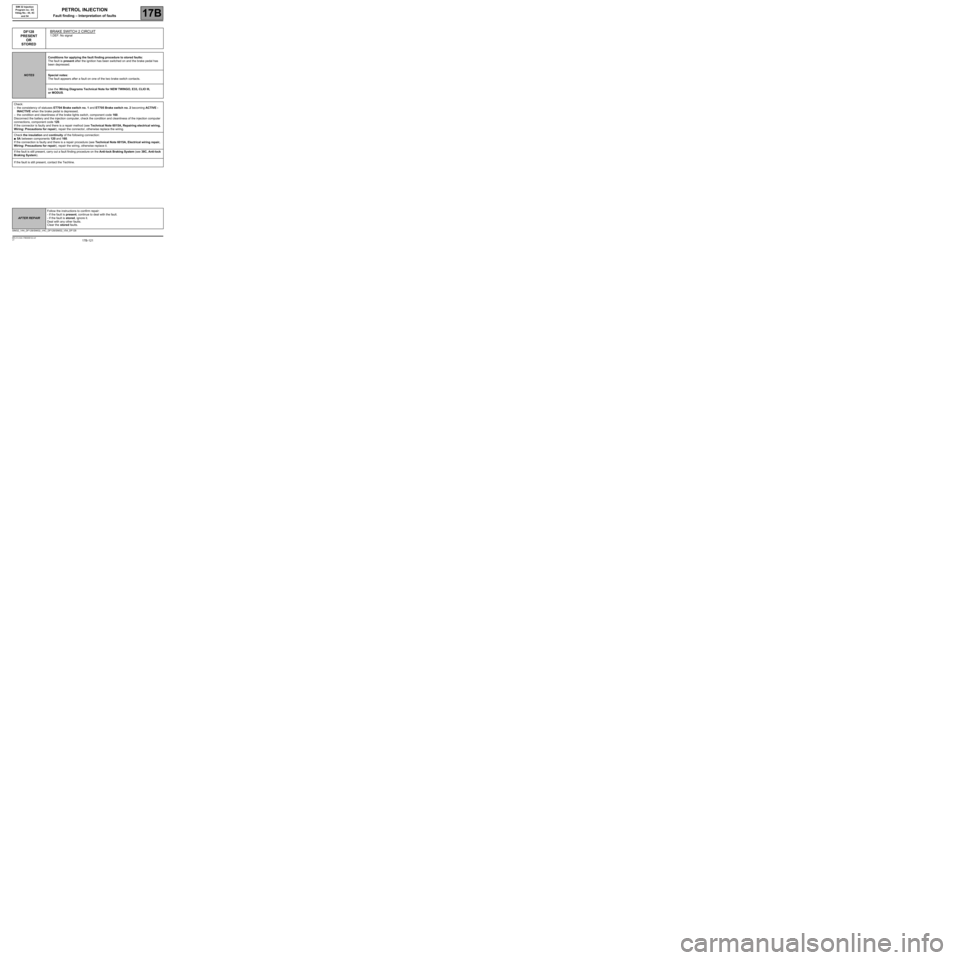
17B-121V7 MR-413-X44-17B000$132.mif
PETROL INJECTION
Fault finding – Interpretation of faults17B
SIM 32 Injection
Program no.: D3
Vdiag No.: 44, 4C
and 54
DF128
PRESENT
OR
STOREDBRAKE SWITCH 2 CIRCUIT
1.DEF: No signal
NOTESConditions for applying the fault finding procedure to stored faults:
The fault is present after the ignition has been switched on and the brake pedal has
been depressed.
Special notes:
The fault appears after a fault on one of the two brake switch contacts.
Use the Wiring Diagrams Technical Note for NEW TWINGO, E33, CLIO III,
or MODUS.
Check:
–the consistency of statuses ET704 Brake switch no. 1 and ET705 Brake switch no. 2 becoming ACTIVE -
INACTIVE when the brake pedal is depressed,
–the condition and cleanliness of the brake lights switch, component code 160.
Disconnect the battery and the injection computer, check the condition and cleanliness of the injection computer
connections, component code 120.
If the connector is faulty and there is a repair method (see Technical Note 6015A, Repairing electrical wiring,
Wiring: Precautions for repair), repair the connector, otherwise replace the wiring.
Check the insulation and continuity of the following connection:
●5A between components 120 and 160.
If the connection is faulty and there is a repair procedure (see Technical Note 6015A, Electrical wiring repair,
Wiring: Precautions for repair), repair the wiring, otherwise replace it.
If the fault is still present, carry out a fault finding procedure on the Anti-lock Braking System (see 38C, Anti-lock
Braking System).
If the fault is still present, contact the Techline.
SIM32_V44_DF128/SIM32_V4C_DF128/SIM32_V54_DF128
AFTER REPAIRFollow the instructions to confirm repair:
- If the fault is present, continue to deal with the fault.
- If the fault is stored, ignore it.
Deal with any other faults.
Clear the stored faults.
Page 160 of 348
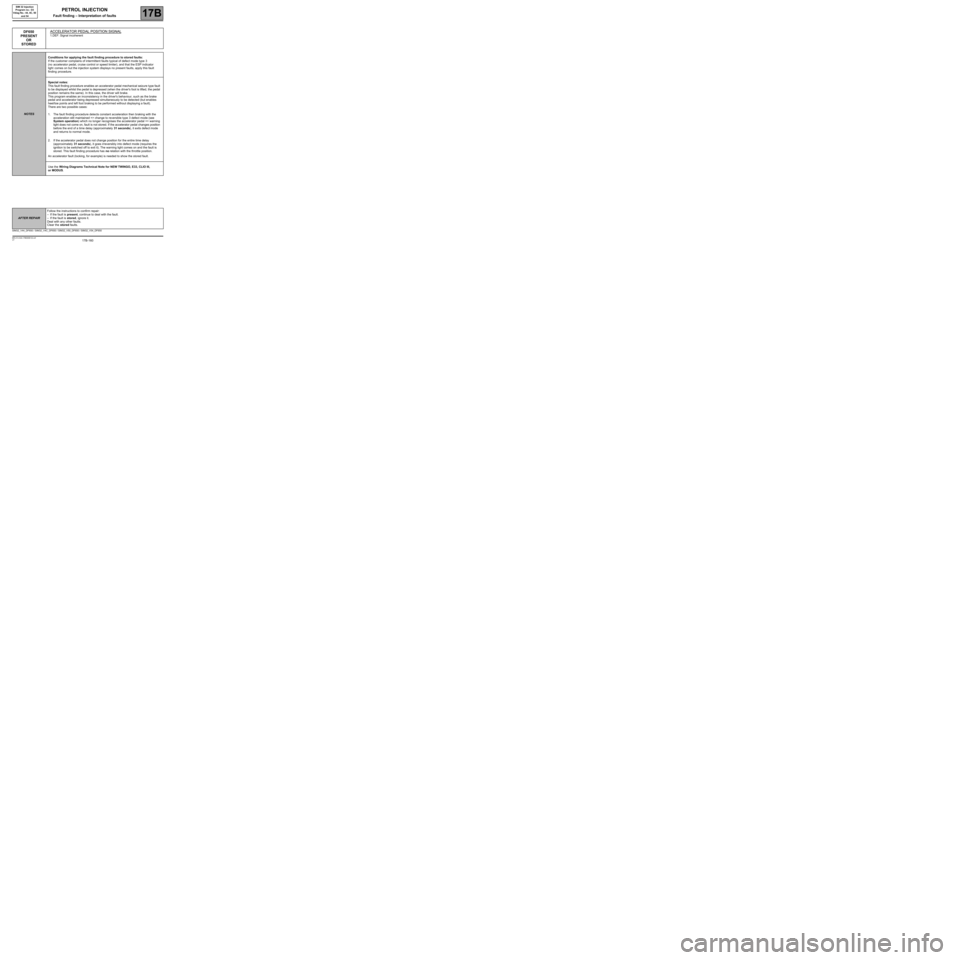
17B-160V7 MR-413-X44-17B000$133.mif
PETROL INJECTION
Fault finding – Interpretation of faults17B
SIM 32 Injection
Program no.: D3
Vdiag No.: 44, 4C, 50
and 54
DF650
PRESENT
OR
STOREDACCELERATOR PEDAL POSITION SIGNAL
1.DEF: Signal incoherent
NOTESConditions for applying the fault finding procedure to stored faults:
If the customer complains of intermittent faults typical of defect mode type 3
(no accelerator pedal, cruise control or speed limiter), and that the ESP indicator
light comes on but the injection system displays no present faults, apply this fault
finding procedure.
Special notes:
This fault finding procedure enables an accelerator pedal mechanical seizure type fault
to be displayed whilst the pedal is depressed (when the driver's foot is lifted, the pedal
position remains the same). In this case, the driver will brake.
This program enables an inconsistency in the driver's behaviour, such as the brake
pedal and accelerator being depressed simultaneously to be detected (but enables
heel/toe points and left foot braking to be performed without displaying a fault).
There are two possible cases:
1. The fault finding procedure detects constant acceleration then braking with the
acceleration still maintained => change to reversible type 3 defect mode (see
System operation) which no longer recognises the accelerator pedal => warning
light does not come on, fault is not stored. If the accelerator pedal changes position
before the end of a time delay (approximately 31 seconds), it exits defect mode
and returns to normal mode.
2. If the accelerator pedal does not change position for the entire time delay
(approximately 31 seconds), it goes irreversibly into defect mode (requires the
ignition to be switched off to exit it). The warning light comes on and the fault is
stored. This fault finding procedure has no relation with the throttle position.
An accelerator fault (locking, for example) is needed to show the stored fault.
Use the Wiring Diagrams Technical Note for NEW TWINGO, E33, CLIO III,
or MODUS.
SIM32_V44_DF650 / SIM32_V4C_DF650 / SIM32_V50_DF650 / SIM32_V54_DF650
AFTER REPAIRFollow the instructions to confirm repair:
–If the fault is present, continue to deal with the fault.
–If the fault is stored, ignore it.
Deal with any other faults.
Clear the stored faults.
Page 196 of 348

17B-196V7 MR-413-X44-17B000$151.mif
PETROL INJECTION
Fault finding – Interpretation of statuses17B
SIM 32 Injection
Program no.: D3
Vdiag No.: 44, 4C, 50
and 54
ET054
CONTINUED
IDLING SPEED TOO LOW
Check:
–engine oil level (too high, splashing),
–that the exhaust pipe is not blocked (catalytic converter damaged),
–the cleanliness and conformity of the air filter,
–that the air inlet circuit is not blocked,
–that the throttle valve assembly is not clogged,
–the condition and conformity of the spark plugs,
–the fuel circuit sealing,
–the fuel pressure and the flow (see MR 392 (Clio III), MR 385 (Modus), MR 411 (New Twingo), or MR 442
(E33), Mechanical, 13A, Fuel supply),
–the condition and cleanliness of the injectors,
–the cylinder compression's,
–the timing setting.
Repair or replace the faulty components, if necessary.
IDLING SPEED TOO HIGH
Check:
–engine oil level (too high, splashing),
–for the fittings in the oil vapour rebreathing system,
–the sealing between the throttle valve and inlet manifold,
–the manifold pressure sensor sealing,
–the fuel vapour absorber bleed, which must not be jammed open,
–the fuel vapour absorber bleed system sealing,
–the brake servo system sealing,
–the sealing between the inlet manifold and cylinder head,
–the oil vapour recovery circuit sealing between the inlet manifold and cylinder head,
–the fuel pressure and the flow (see MR 392 (Clio III), MR 385 (Modus), MR 411 (New Twingo), or MR 442
(E33), Mechanical, 13A, Fuel supply),
–the condition and cleanliness of the injectors,
–the cylinder compression's,
–the timing adjustment,
Repair or replace the faulty components, if necessary.
AFTER REPAIRCarry out a road test, then check with the diagnostic tool.
Page 225 of 348

17B-225V7 MR-413-X44-17B000$152.mif
PETROL INJECTION
Fault finding – Interpretation of statuses17B
SIM 32 Injection
Program no.: D3
Vdiag No.: 44, 4C, 50
and 54
ET351INJECTION ELECTRONIC STABILITY PROGRAM CONNECTION
STATUS
DEFINITIONCONNECTED: This status indicates that the connection between the injection
computer and the ESP is not defective.
DISCONNECTED: This status indicates that the connection between the injection
computer and the ESP is defective.
NOTESSpecial notes:
Perform these checks if the parameters correspond with the system operation
programming.
Conformity check with engine stopped and ignition on, or engine running, and engine coolant
temperature > 80˚C
NOT CONNECTEDThe connection between the injection computer and the ESP is defective, test the
ABS/ESP computer (see 38C, Anti-lock braking system) and the multiplex network
(see 88B, Multiplexing).
SIM32_V44_ET351/SIM32_V4C_ET351/SIM32_V50_ET351/SIM32_V54_ET351
AFTER REPAIRCarry out a road test followed by a check with the diagnostic tool.
Page 230 of 348
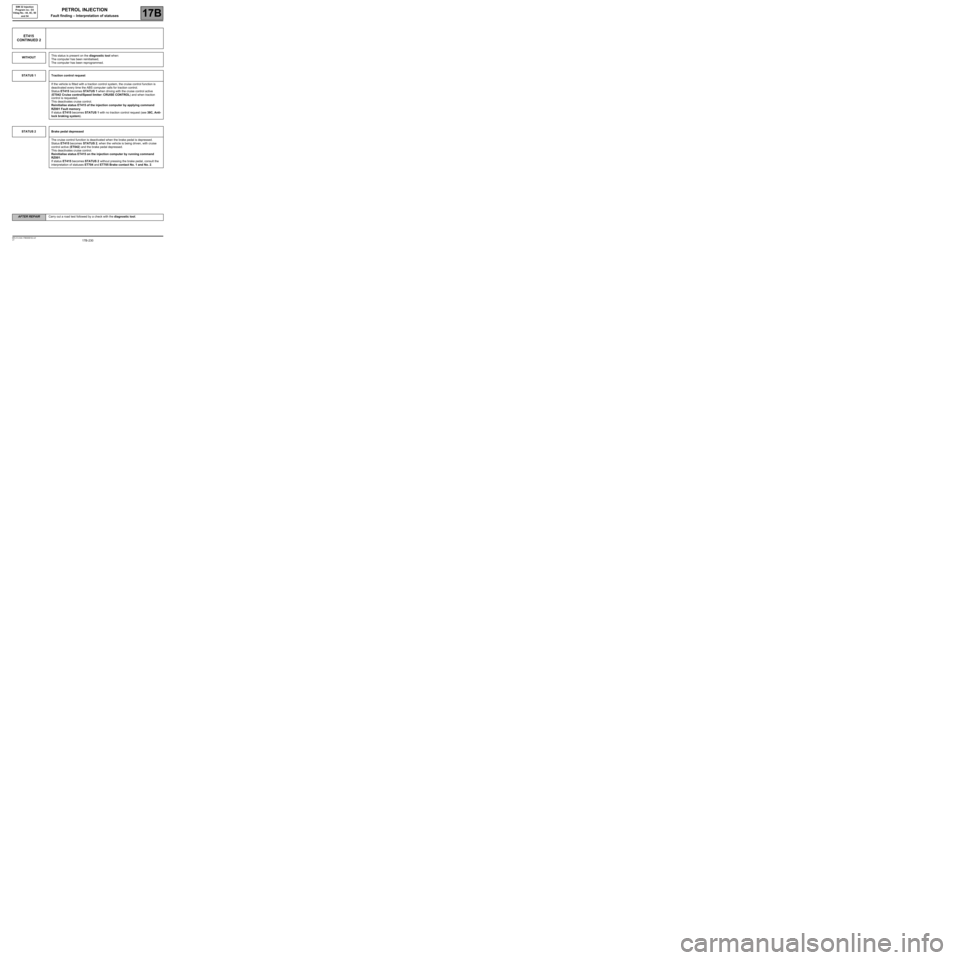
17B-230V7 MR-413-X44-17B000$152.mif
PETROL INJECTION
Fault finding – Interpretation of statuses17B
SIM 32 Injection
Program no.: D3
Vdiag No.: 44, 4C, 50
and 54
ET415
CONTINUED 2
WITHOUTThis status is present on the diagnostic tool when:
The computer has been reinitialised,
The computer has been reprogrammed.
STATUS 1 Traction control request
If the vehicle is fitted with a traction control system, the cruise control function is
deactivated every time the ABS computer calls for traction control.
Status ET415 becomes STATUS 1 when driving with the cruise control active
(ET042 Cruise control/Speed limiter: CRUISE CONTROL) and when traction
control is requested.
This deactivates cruise control.
Reinitialise status ET415 of the injection computer by applying command
RZ001 Fault memory.
If status ET415 becomes STATUS 1 with no traction control request (see 38C, Anti-
lock braking system).
STATUS 2 Brake pedal depressed
The cruise control function is deactivated when the brake pedal is depressed.
Status ET415 becomes STATUS 2, when the vehicle is being driven, with cruise
control active (ET042) and the brake pedal depressed.
This deactivates cruise control.
Reinitialise status ET415 on the injection computer by running command
RZ001.
If status ET415 becomes STATUS 2 without pressing the brake pedal, consult the
interpretation of statuses ET704 and ET705 Brake contact No. 1 and No. 2.
AFTER REPAIRCarry out a road test followed by a check with the diagnostic tool.
Page 235 of 348
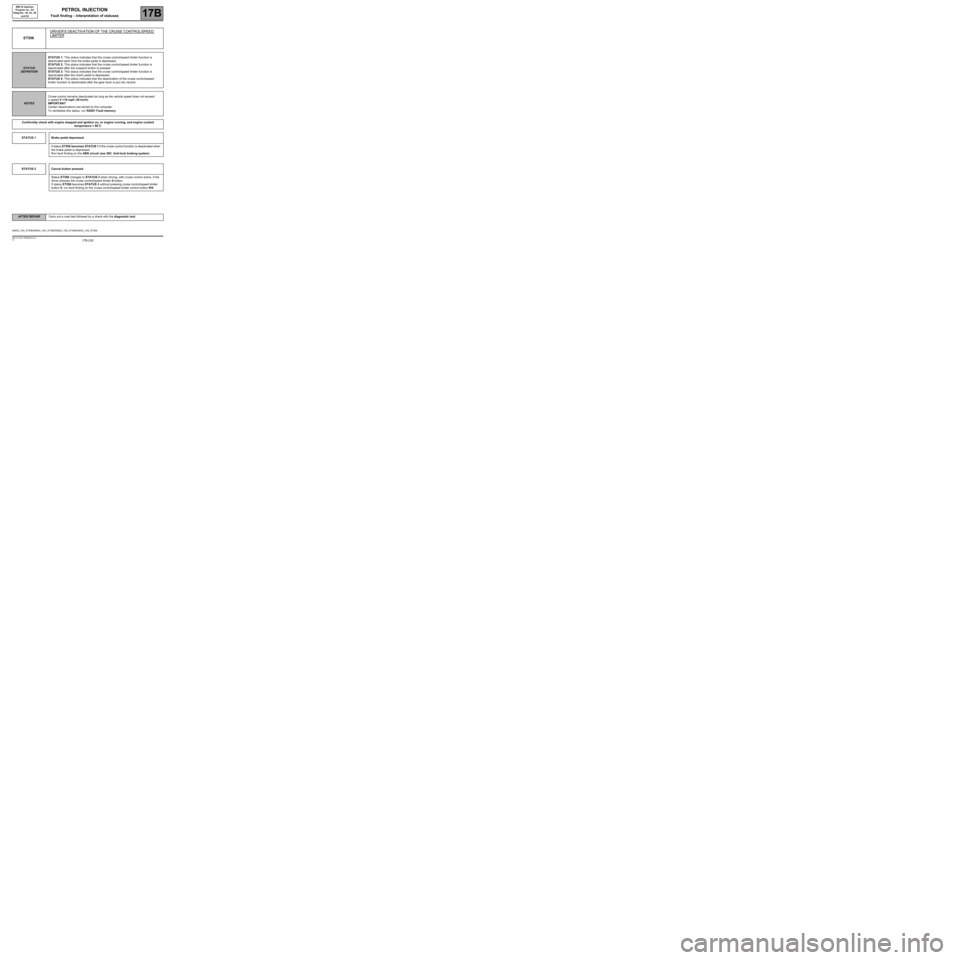
17B-235V7 MR-413-X44-17B000$152.mif
PETROL INJECTION
Fault finding – Interpretation of statuses17B
SIM 32 Injection
Program no.: D3
Vdiag No.: 44, 4C, 50
and 54
ET556DRIVER'S DEACTIVATION OF THE CRUISE CONTROL/SPEED LIMITER
STATUS
DEFINITIONSTATUS 1: This status indicates that the cruise control/speed limiter function is
deactivated each time the brake pedal is depressed.
STATUS 2: This status indicates that the cruise control/speed limiter function is
deactivated after the suspend button is pressed.
STATUS 3: This status indicates that the cruise control/speed limiter function is
deactivated after the clutch pedal is depressed.
STATUS 4: This status indicates that the deactivation of the cruise control/speed
limiter function is deactivated after the gear lever is put into neutral.
NOTESCruise control remains deactivated as long as the vehicle speed does not exceed
a speed V >18 mph (30 km/h).
IMPORTANT
Certain deactivations are stored by the computer.
To reinitialise this status, run RZ001 Fault memory.
Conformity check with engine stopped and ignition on, or engine running, and engine coolant
temperature > 80˚C
STATUS 1 Brake pedal depressed
If status ET556 becomes STATUS 1 if the cruise control function is deactivated when
the brake pedal is depressed.
Run fault finding on the ABS circuit (see 38C, Anti-lock braking system).
STATUS 2 Cancel button pressed
Status ET556 changes to STATUS 3 when driving, with cruise control active, if the
driver presses the cruise control/speed limiter 0 button.
If status ET556 becomes STATUS 3 without pressing cruise control/speed limiter
button 0, run fault finding on the cruise control/speed limiter control button R/0.
SIM32_V44_ET556/SIM32_V4C_ET556/SIM32_V50_ET556/SIM32_V54_ET556
AFTER REPAIRCarry out a road test followed by a check with the diagnostic tool.
Page 238 of 348
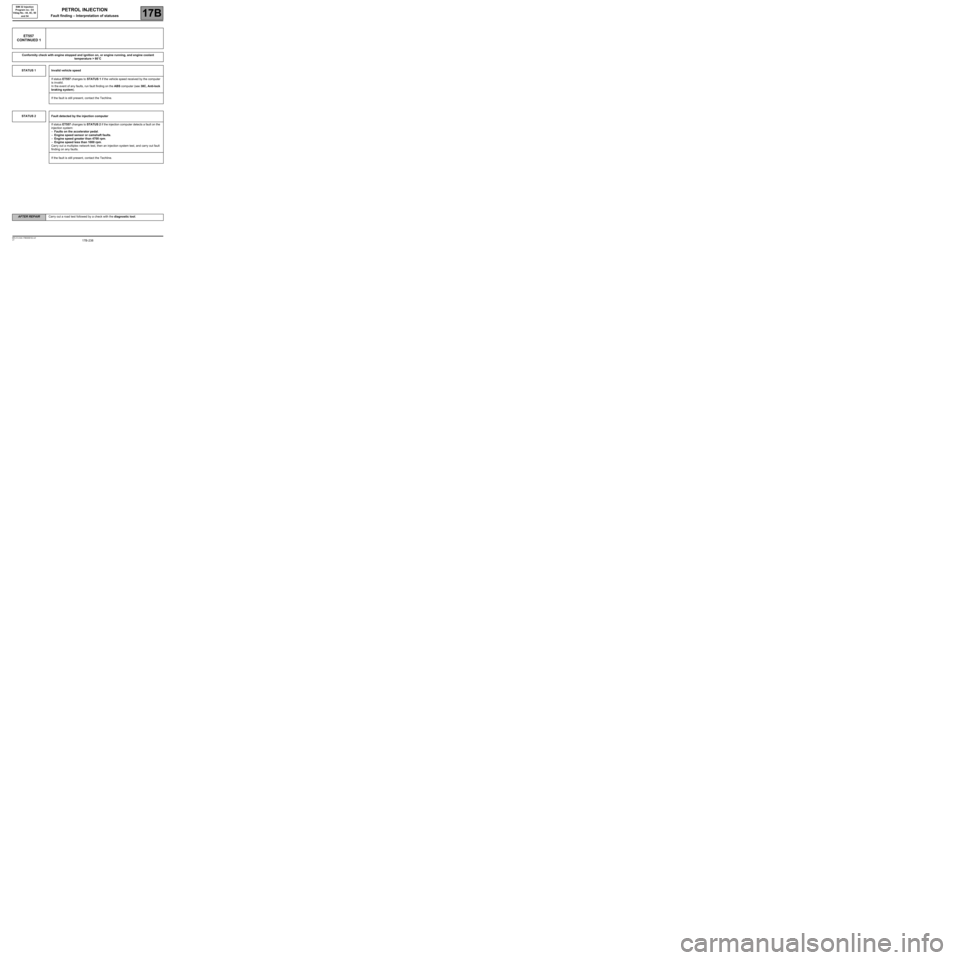
17B-238V7 MR-413-X44-17B000$152.mif
PETROL INJECTION
Fault finding – Interpretation of statuses17B
SIM 32 Injection
Program no.: D3
Vdiag No.: 44, 4C, 50
and 54
ET557
CONTINUED 1
Conformity check with engine stopped and ignition on, or engine running, and engine coolant
temperature > 80˚C
STATUS 1 Invalid vehicle speed
If status ET557 changes to STATUS 1 if the vehicle speed received by the computer
is invalid.
In the event of any faults, run fault finding on the ABS computer (see 38C, Anti-lock
braking system).
If the fault is still present, contact the Techline.
STATUS 2 Fault detected by the injection computer
If status ET557 changes to STATUS 2 if the injection computer detects a fault on the
injection system:
–Faults on the accelerator pedal.
–Engine speed sensor or camshaft faults.
–Engine speed greater than 4700 rpm.
–Engine speed less than 1000 rpm.
Carry out a multiplex network test, then an injection system test, and carry out fault
finding on any faults.
If the fault is still present, contact the Techline.
AFTER REPAIRCarry out a road test followed by a check with the diagnostic tool.
Page 239 of 348
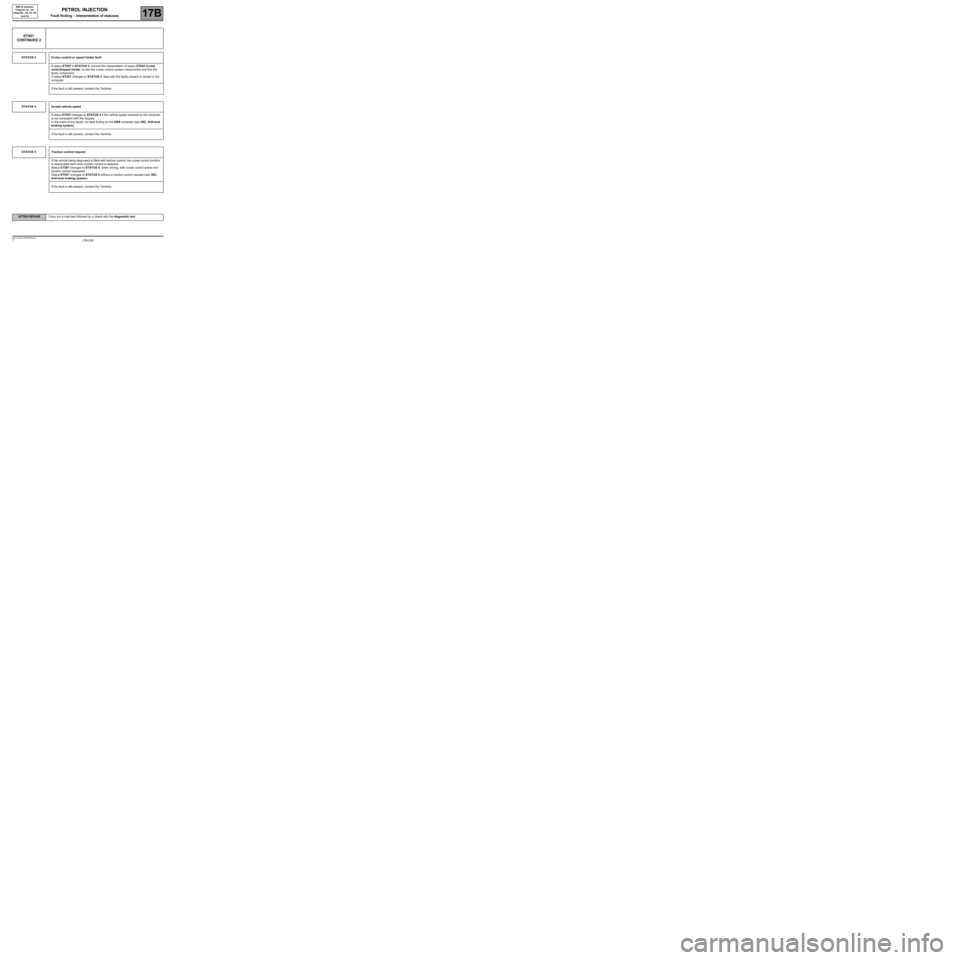
17B-239V7 MR-413-X44-17B000$152.mif
PETROL INJECTION
Fault finding – Interpretation of statuses17B
SIM 32 Injection
Program no.: D3
Vdiag No.: 44, 4C, 50
and 54
ET557
CONTINUED 2
STATUS 3 Cruise control or speed limiter fault
If status ET557 is STATUS 3, consult the interpretation of status ET042 Cruise
control/speed limiter, to test the cruise control system components and find the
faulty component.
If status ET557 changes to STATUS 3, deal with the faults present or stored in the
computer.
If the fault is still present, contact the Techline.
STATUS 4 Invalid vehicle speed
If status ET557 changes to STATUS 4 if the vehicle speed received by the computer
is not consistent with the request.
In the event of any faults, run fault finding on the ABS computer (see 38C, Anti-lock
braking system).
If the fault is still present, contact the Techline.
STATUS 5 Traction control request
If the vehicle being diagnosed is fitted with traction control, the cruise control function
is deactivated each time traction control is selected.
Status ET557 changes to STATUS 5, when driving, with cruise control active and
traction control requested.
Status ET557 changes to STATUS 5 without a traction control request (see 38C,
Anti-lock braking system).
If the fault is still present, contact the Techline.
AFTER REPAIRCarry out a road test followed by a check with the diagnostic tool.
Page 274 of 348
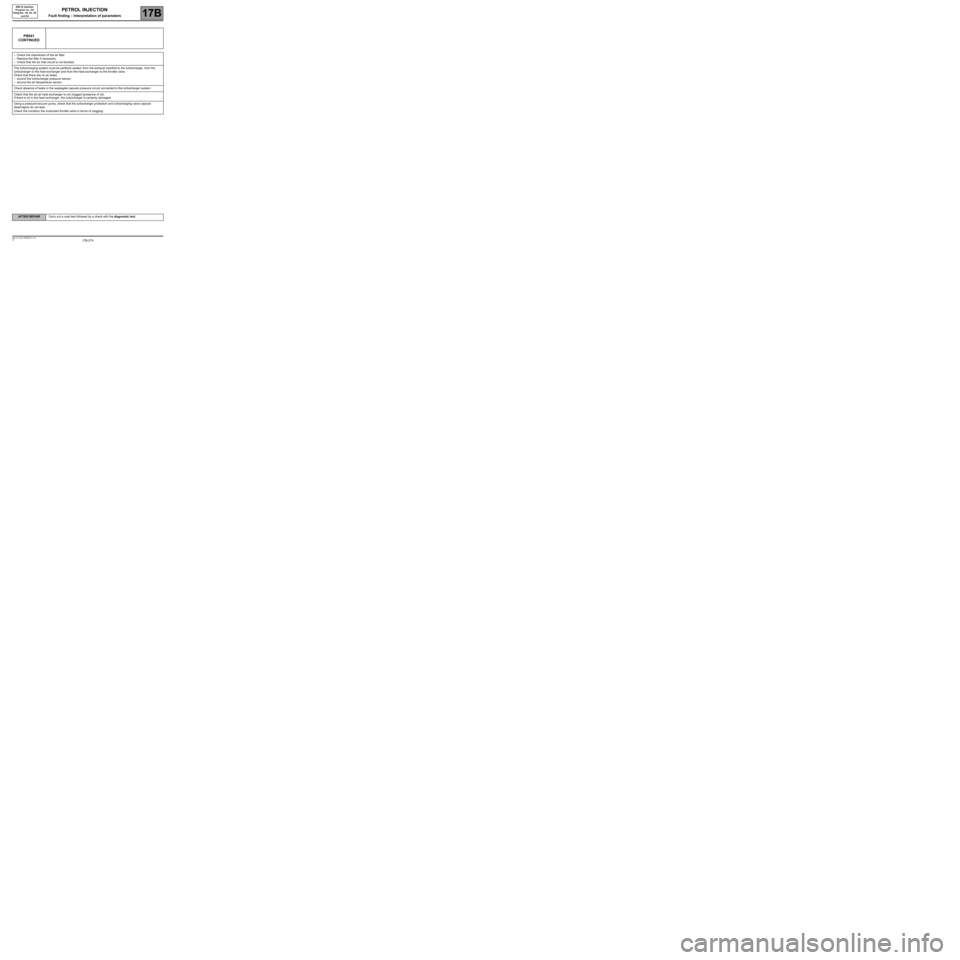
17B-274V7 MR-413-X44-17B000$171.mif
PETROL INJECTION
Fault finding – Interpretation of parameters17B
SIM 32 Injection
Program no.: D3
Vdiag No.: 44, 4C, 50
and 54
PR041
CONTINUED
–Check the cleanliness of the air filter.
–Replace the filter if necessary.
–Check that the air inlet circuit is not blocked.
The turbocharging system must be perfectly sealed, from the exhaust manifold to the turbocharger, from the
turbocharger to the heat exchanger and from the heat exchanger to the throttle valve.
Check that there are no air leaks:
–around the turbocharger pressure sensor,
–around the air temperature sensor.
Check absence of leaks in the wastegate capsule pressure circuit connected to the turbocharger system.
Check that the air-air heat exchanger is not clogged (presence of oil).
If there is oil in the heat exchanger, the turbocharger is certainly damaged.
Using a pressure/vacuum pump, check that the turbocharger protection and turbocharging valve capsule
diaphragms do not leak.
Check the condition the motorised throttle valve in terms of clogging.
AFTER REPAIRCarry out a road test followed by a check with the diagnostic tool.
Page 279 of 348
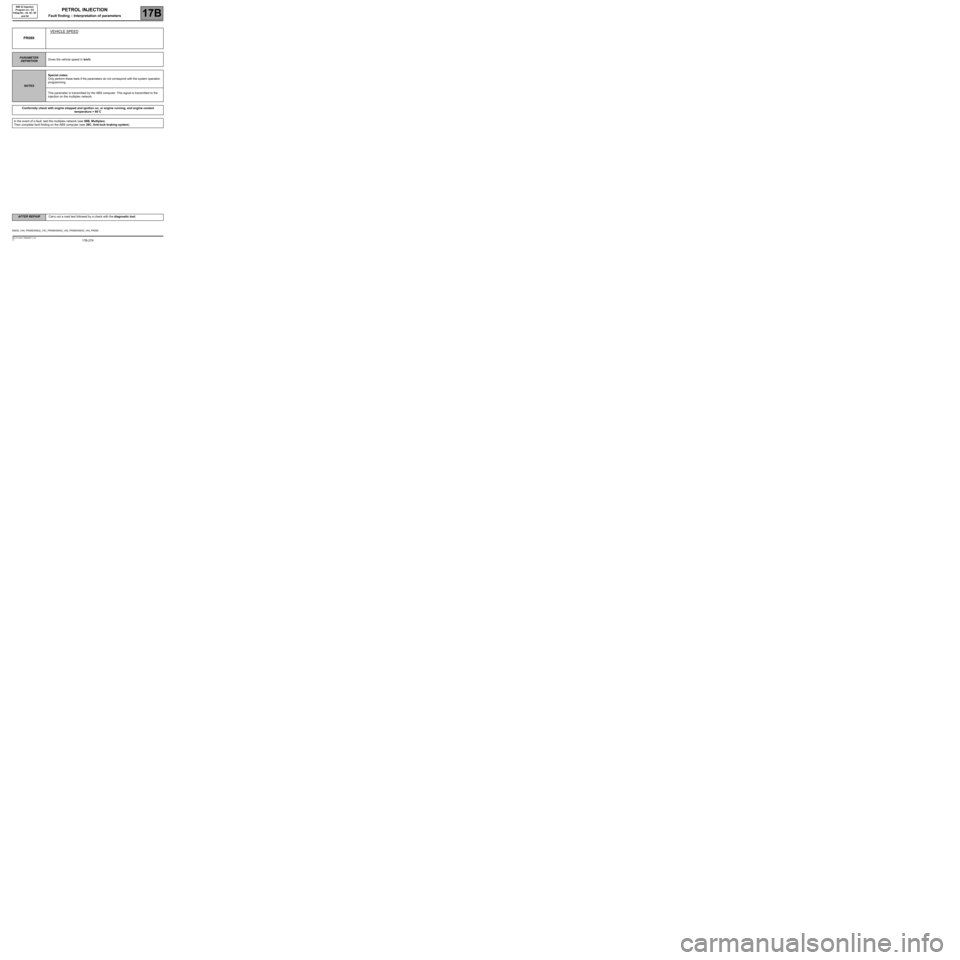
17B-279V7 MR-413-X44-17B000$171.mif
PETROL INJECTION
Fault finding – Interpretation of parameters17B
SIM 32 Injection
Program no.: D3
Vdiag No.: 44, 4C, 50
and 54
PR089VEHICLE SPEED
PARAMETER
DEFINITIONGives the vehicle speed in km/h.
NOTESSpecial notes:
Only perform these tests if the parameters do not correspond with the system operation
programming.
This parameter is transmitted by the ABS computer. This signal is transmitted to the
injection on the multiplex network.
Conformity check with engine stopped and ignition on, or engine running, and engine coolant
temperature > 80˚C
In the event of a fault, test the multiplex network (see 88B, Multiplex).
Then complete fault finding on the ABS computer (see 38C, Anti-lock braking system).
SIM32_V44_PR089/SIM32_V4C_PR089/SIM32_V50_PR089/SIM32_V54_PR089
AFTER REPAIRCarry out a road test followed by a check with the diagnostic tool.